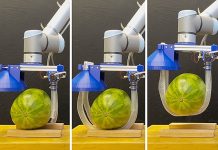
Imagine a robot tiny enough to squeeze through cracks and gaps, just like a spider does.
Engineers at the University of Colorado Boulder have made this a reality with their latest creation, mCLARI.
This little robot is a marvel of miniaturization, able to change its shape and slip through tight spaces with ease.
And guess what?
It’s now even tinier than before, making it perfect for jobs that require a delicate touch.
Kaushik Jayaram and his student, Heiko Kabutz, are the brains behind mCLARI. Their hard work recently won them a big award at a major robotics conference, and it’s easy to see why.
The new version of their robot is not just smaller; it’s also three times faster than the old one, zipping along at a speed that would make any tiny critter proud.
mCLARI might be lightweight, weighing less than a candy wrapper, but it’s no weakling. It can carry items three times its own weight, which is pretty impressive.
Think about carrying three people on your back while running, and you get the idea!
The secret behind mCLARI’s abilities is its design, which is inspired by origami. That’s right, the same kind of paper folding you might have done to make a paper crane.
Jayaram and his team used this idea to make robots that are not just small, but also very good at moving around.
And if you need to check on something like a jet engine, a tiny robot like this can go places where humans can’t.
Heiko Kabutz, who leads the study, has a talent for making these minuscule robots. He used to love building big robots, but working in Jayaram’s lab showed him the wonders of making tiny, bug-sized ones. And these small robots aren’t just for show.
They can be useful in real-life situations, like helping after disasters, keeping an eye on the environment, or even in surgeries.
These robots, like mCLARI, are not one-trick ponies. They can move in different shapes and use various speeds, just like an animal adjusting to its surroundings. The team looks at real bugs and spiders to get ideas on how to make their robots move and act in the real world.
The team at Jayaram’s lab is not just about building cool robots. They want to understand animals better and use that knowledge to solve problems that matter to us, like finding people after an earthquake or exploring places too small or dangerous for humans.
The new study by this innovative team is not a solo effort. Other smart folks like Alex Hedrick and Parker McDonnell, also from the mechanical engineering department, have pitched in.
In a nutshell, the University of Colorado Boulder’s latest robot, mCLARI, is a big deal in a tiny package. It’s fast, strong, and can get into the nooks and crannies of the world where we need eyes and hands the most.
This could change the game in how we do a lot of important work, making it safer and more efficient. So the next time you see a spider crawling through a tight space, just think: there’s a robot that can do that too!
Follow us on Twitter for more articles about this topic.



